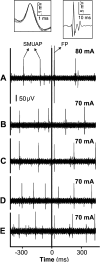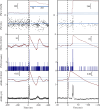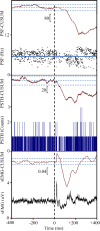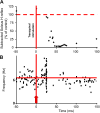Postsynaptic potentials of soleus motor neurons produced by transspinal stimulation: a human single-motor unit study
- PMID: 38656134
- PMCID: PMC11381115
- DOI: 10.1152/jn.00077.2024
Postsynaptic potentials of soleus motor neurons produced by transspinal stimulation: a human single-motor unit study
Abstract
Transspinal (or transcutaneous spinal cord) stimulation is a noninvasive, cost-effective, easily applied method with great potential as a therapeutic modality for recovering somatic and nonsomatic functions in upper motor neuron disorders. However, how transspinal stimulation affects motor neuron depolarization is poorly understood, limiting the development of effective transspinal stimulation protocols for rehabilitation. In this study, we characterized the responses of soleus α motor neurons to single-pulse transspinal stimulation using single-motor unit (SMU) discharges as a proxy given the 1:1 discharge activation between the motor neuron and the motor unit. Peristimulus time histogram, peristimulus frequencygram, and surface electromyography (sEMG) were used to characterize the postsynaptic potentials of soleus motor neurons. Transspinal stimulation produced short-latency excitatory postsynaptic potentials (EPSPs) followed by two distinct phases of inhibitory postsynaptic potentials (IPSPs) in most soleus motor neurons and only IPSPs in others. Transspinal stimulation generated double discharges at short interspike intervals in a few motor units. The short-latency EPSPs were likely mediated by muscle spindle group Ia and II afferents, and the IPSPs via excitation of group Ib afferents and recurrent collaterals of motor neurons leading to activation of diverse spinal inhibitory interneuronal circuits. Further studies are warranted to understand better how transspinal stimulation affects depolarization of α motor neurons over multiple spinal segments. This knowledge will be seminal for developing effective transspinal stimulation protocols in upper motor neuron lesions.NEW & NOTEWORTHY Transspinal stimulation produces distinct actions on soleus motor neurons: an early short-latency excitation followed by two inhibitions or only inhibition and doublets. These results show how transspinal stimulation affects depolarization of soleus α motor neurons in healthy humans.
Keywords: motoneurons; motor units; postsynaptic potentials; transcutaneous spinal cord stimulation; transspinal stimulation.
Conflict of interest statement
No conflicts of interest, financial or otherwise, are declared by the authors.
Figures






Similar articles
-
Repeated transspinal stimulation decreases soleus H-reflex excitability and restores spinal inhibition in human spinal cord injury.PLoS One. 2019 Sep 26;14(9):e0223135. doi: 10.1371/journal.pone.0223135. eCollection 2019. PLoS One. 2019. PMID: 31557238 Free PMC article. Clinical Trial.
-
Paired associative transspinal and transcortical stimulation produces plasticity in human cortical and spinal neuronal circuits.J Neurophysiol. 2016 Aug 1;116(2):904-16. doi: 10.1152/jn.00259.2016. Epub 2016 Jun 8. J Neurophysiol. 2016. PMID: 27281748 Free PMC article.
-
Interactions between arm and leg neuronal circuits following paired cervical and lumbosacral transspinal stimulation in healthy humans.Exp Brain Res. 2024 Sep;242(9):2229-2239. doi: 10.1007/s00221-024-06891-y. Epub 2024 Jul 22. Exp Brain Res. 2024. PMID: 39034329
-
Alternation of agonists and antagonists during turtle hindlimb motor rhythms.Ann N Y Acad Sci. 2010 Jun;1198:105-18. doi: 10.1111/j.1749-6632.2010.05500.x. Ann N Y Acad Sci. 2010. PMID: 20536925 Free PMC article. Review.
-
Partitioning of monosynaptic Ia excitatory postsynaptic potentials in the motor nucleus of the cat lateral gastrocnemius muscle.J Neurophysiol. 1986 Mar;55(3):569-86. doi: 10.1152/jn.1986.55.3.569. J Neurophysiol. 1986. PMID: 3514815 Review.
Cited by
-
Optimizing Transcutaneous Spinal Cord Stimulation: An Exploratory Study on the Role of Electrode Montages and Stimulation Intensity on Reflex Pathway Modulation.Bioengineering (Basel). 2025 Apr 12;12(4):410. doi: 10.3390/bioengineering12040410. Bioengineering (Basel). 2025. PMID: 40281770 Free PMC article.
References
-
- Gorodnichev RM, Pivovarova EA, Puhov A, Moiseev SA, Savochin AA, Moshonkina TR, Chsherbakova NA, Kilimnik VA, Selionov VA, Kozlovskaya IB, Edgerton VR, Gerasimenko YP. Transcutaneous electrical stimulation of the spinal cord: a noninvasive tool for the activation of stepping pattern generators in humans. Hum Physiol 38: 158–167, 2012. doi:10.1134/S0362119712020065. - DOI - PubMed
Publication types
MeSH terms
Grants and funding
LinkOut - more resources
Full Text Sources

